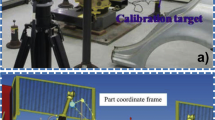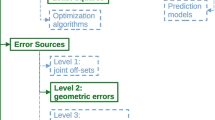Abstract
In this paper, we consider environmental boundaries that can be represented by a time-varying closed curve. We use n robots equipped with location sensors to sample the dynamic boundary. The main difficulty during the prediction process is that only n boundary points can be observed at each time step. Our approach combines finite Fourier series for shape-estimation and polynomial fitting for point tracking in time. This combination gives a continuous parametric function that describes the boundary shape and its dynamics. We validate our strategy in simulation and with experiments using actual robots. We tested on non-convex boundaries assuming noisy measurements and inaccurate motion actuators.













Similar content being viewed by others
Notes
The dataset: https://github.com/dsaldana/boundary-dataset
The video is available at https://youtu.be/Zwc6vNuUFDw
References
Barat, C., & Rendas, M. J. (2003). Benthic boundary tracking using a profiler sonar. In Proceedings 2003 IEEE/RSJ International Conference on Intelligent Robots and Systems (IROS 2003), (Vol. 1, pp. 830–835). IEEE
Bertozzi, A. L., Kemp, M., & Marthaler, D. (2005). Determining environmental boundaries: Asynchronous communication and physical scales (pp. 25–42). Berlin: Springer. https://doi.org/10.1007/978-3-540-31595-7_2.
Bruemmer, D. J., Dudenhoeffer, D. D., McKay, M. D., & Anderson, M. O. (2002). A robotic swarm for spill finding and perimeter formation. DTIC Document, Technical Report.
Casbeer, D., Beard, R., McLain, T., Li, S., & Mehra, R. (2005). Forest fire monitoring with multiple small uavs. In Proceedings of the 2005 American Control Conference (pp. 3530–3535). IEEE.
Casbeer, D., Kingston, D., Beard, R., & McLain, T. (2006). Cooperative forest fire surveillance using a team of small unmanned air vehicles. International Journal of Systems Science, 37(6), 351–360.
Clark, J., & Fierro, R. (2005). Cooperative hybrid control of robotic sensors for perimeter detection and tracking. In Proceedings of the 2005, American Control Conference (pp. 3500–3505).
Cortés, J. (2012). Cooperative detection of areas of rapid change in spatial fields. Automatica, 48(4), 673–681.
Cruz, D., McClintock, J., Perteet, B., Orqueda, O., Cao, Y., & Fierro, R. (2007). Decentralized cooperative control: A multivehicle platform for research in networked embedded systems. IEEE Control Systems, 27(3), 58–78. https://doi.org/10.1109/MCS.2007.365004.
Duttagupta, S., Ramamritham, K., & Kulkarni, P. (2011). Tracking dynamic boundaries using sensor network. IEEE Transactions on Parallel and Distributed Systems, 22(10), 1766–1774.
Fahad, M., Saul, N., Guo, Y., & Bingham, B. (2015). Robotic simulation of dynamic plume tracking by unmanned surface vessels. In 2015 IEEE International Conference on Robotics and Automation (ICRA) (pp. 2654–2659). https://doi.org/10.1109/ICRA.2015.7139557.
Franchi, A., Stegagno, P., Di Rocco, M., & Oriolo, G. (2010). Distributed target localization and encirclement with a multi-robot system. In 7th IFAC Symposium on Intelligent Autonomous Vehicles (pp. 151–156).
Hsieh, C. H., Jin, Z., Marthaler, D., Nguyen, B. Q., Tung, D. J., Bertozzi, A. L., & Murray, R. M. (2005). Experimental validation of an algorithm for cooperative boundary tracking. In Proceedings of the 2005 American Control Conference (Vol. 2, pp. 1078–1083)
Hsieh, M. A., Kumar, V., & Chaimowicz, L. (2008). Decentralized controllers for shape generation with robotic swarms. Robotica, 26(05), 691–701.
Jin, Z., & Bertozzi, A. L. (2007). Environmental boundary tracking and estimation using multiple autonomous vehicles. In 2007 46th IEEE Conference on Decision and Control (pp. 4918–4923). https://doi.org/10.1109/CDC.2007.4434857.
Joshi, A., Ashley, T., Huang, Y.R., & Bertozzi, A. L. (2009). Experimental validation of cooperative environmental boundary tracking with on-board sensors. In Proceedings of the 2009 Conference on American Control Conference, ACC’09 (pp. 2630–2635).
Kemp, M., Bertozzi, A. L., & Marthaler, D. (2004). Multi-uuv perimeter surveillance. In 2004 IEEE/OES Autonomous Underwater Vehicles (IEEE Cat. No. 04CH37578) (pp. 102–107).
Li, S., Guo, Y., & Bingham, B. (2014). Multi-robot cooperative control for monitoring and tracking dynamic plumes. In 2014 IEEE International Conference on Robotics and Automation (ICRA) (pp. 67–73).
Marthaler, D., Bertozzi, A. (2003a). Collective motion algorithms for determining environmental boundaries. In SIAM Conference on Applications of Dynamical Systems
Marthaler, D., & Bertozzi, A. (2003b). Tracking environmental level sets with autonomous vehicles. Journal of the Electrochemical Society, 129, 2865.
Matveev, A. S., Hoy, M. C., Ovchinnikov, K., Anisimov, A., & Savkin, A. V. (2015). Robot navigation for monitoring unsteady environmental boundaries without field gradient estimation. Automatica, 62, 227–235.
Matveev, A. S., Semakova, A. A., & Savkin, A. V. (2017). Tight circumnavigation of multiple moving targets based on a new method of tracking environmental boundaries. Automatica, 79, 52–60.
Mellucci, C., Menon, P., Edwards, C., & Challenor, P. (2017). Experimental validation of boundary tracking using the suboptimal sliding mode algorithm. In 2017 American Control Conference (pp. 4878–4883).
Menon, P. P., & Ghose, D. (2013). Boundary mapping of 3-dimensional regions. In 2013 American Control Conference (pp. 2984–2989). https://doi.org/10.1109/ACC.2013.6580288.
Menon, P.P., Edwards, C., Shtessel, Y. B., Ghose, D., & Haywood, J. (2014). Boundary tracking using a suboptimal sliding mode algorithm. In 53rd IEEE Conference on Decision and Control (pp. 5518–5523). https://doi.org/10.1109/CDC.2014.7040252.
Nagarathna, S. V. (2015). An adaptive refresh distributed model for estimation and efficient tracking of dynamic boundaries. In: 2015 Twenty First National Conference on Communications (NCC) (pp. 1–6).
Nagarathna, Valli S., & Manjunath, D. (2014). A spatio-temporal model for estimation and efficient tracking of dynamic boundaries. In 2014 Twentieth National Conference on Communications (NCC) (pp. 1–6). https://doi.org/10.1109/NCC.2014.6811335.
Pettersson, L. H., & Pozdnyakov, D. (2012). Monitoring of harmful algal blooms. Berlin: Springer.
Saldaña, D., Assunção, R., & Campos, M. (2015). A distributed multi-robot approach for the detection and tracking of multiple dynamic anomalies. In: 2015 IEEE International Conference on Robotics and Automation (ICRA) (pp. 1262–1267). https://doi.org/10.1109/ICRA.2015.7139353.
Saldaña, D., Assunção, R., & Campos, M. (2016). Predicting environmental boundary behaviors with a mobile robot. IEEE Robotics and Automation Letters, 1(2), 1133–1139. https://doi.org/10.1109/LRA.2016.2522500.
Saldaña, D., Assunção, R., Hsieh, M. A., Campos, M. F. M., & Kumar, V. (2017). Cooperative prediction of time-varying boundaries with a team of robots. In: 2017 International Symposium on Multi-Robot and Multi-Agent Systems (MRS) (pp 9–16). https://doi.org/10.1109/MRS.2017.8250925.
Sherman, J., & Morrison, W. J. (1950). Adjustment of an inverse matrix corresponding to a change in one element of a given matrix. The Annals of Mathematical Statistics, 21(1), 124–127.
Smith, L. C. (1997). Satellite remote sensing of river inundation area, stage, and discharge: A review. Hydrological processes, 11(10), 1427–1439.
Srinivasan, S., Ramamritham, K., & Kulkarni, P. (2008). Ace in the hole: Adaptive contour estimation using collaborating mobile sensors. In: 2008 International Conference on Information Processing in Sensor Networks (ipsn 2008) (pp. 147–158). https://doi.org/10.1109/IPSN.2008.38.
Susca, S., Bullo, F., & Martinez, S. (2008). Monitoring environmental boundaries with a robotic sensor network. IEEE Transactions on Control Systems Technology, 16(2), 288–296.
Susca, S., Bullo, F., & Martinez, S. (2009). Gradient algorithms for polygonal approximation of convex contours. Automatica, 45(2), 510–516. https://doi.org/10.1016/j.automatica.2008.08.020.
Turgeman, A., & Werner, H. (2017). Mission control-combined solutions for source seeking and level curve tracking in a time-varying field. In: 2017 American Control Conference (pp. 4268–4273).
White, B., Tsourdos, A., Ashokaraj, I., Subchan, S., & Zbikowski, R. (2007). Contaminant cloud boundary monitoring using uav sensor swarms. In AIAA Guidance, Navigation and Control Conference and Exhibit (p. 6761).
Zhang, F., & Leonard, N. E .(2005). Generating contour plots using multiple sensor platforms. In: IEEE Swarm Intelligence Symposium (pp. 309–316).
Zhang, F., & Leonard, N. E. (2010). Cooperative filters and control for cooperative exploration. IEEE Transactions on Automatic Control, 55(3), 650–663. https://doi.org/10.1109/TAC.2009.2039240.
Zhang, G., Fricke, G. K., & Garg, D. P. (2013). Spill detection and perimeter surveillance via distributed swarming agents. IEEE/ASME Transactions on Mechatronics, 18(1), 121–129.
Author information
Authors and Affiliations
Corresponding author
Additional information
Publisher's Note
Springer Nature remains neutral with regard to jurisdictional claims in published maps and institutional affiliations.
This is one of the several papers published in Autonomous Robots comprising the Special Issue on Multi-Robot and Multi-Agent Systems.
Rights and permissions
About this article
Cite this article
Saldaña, D., Assunção, R., Hsieh, M.A. et al. Estimating boundary dynamics using robotic sensor networks with pointwise measurements. Auton Robot 45, 193–208 (2021). https://doi.org/10.1007/s10514-020-09954-5
Received:
Accepted:
Published:
Issue Date:
DOI: https://doi.org/10.1007/s10514-020-09954-5




